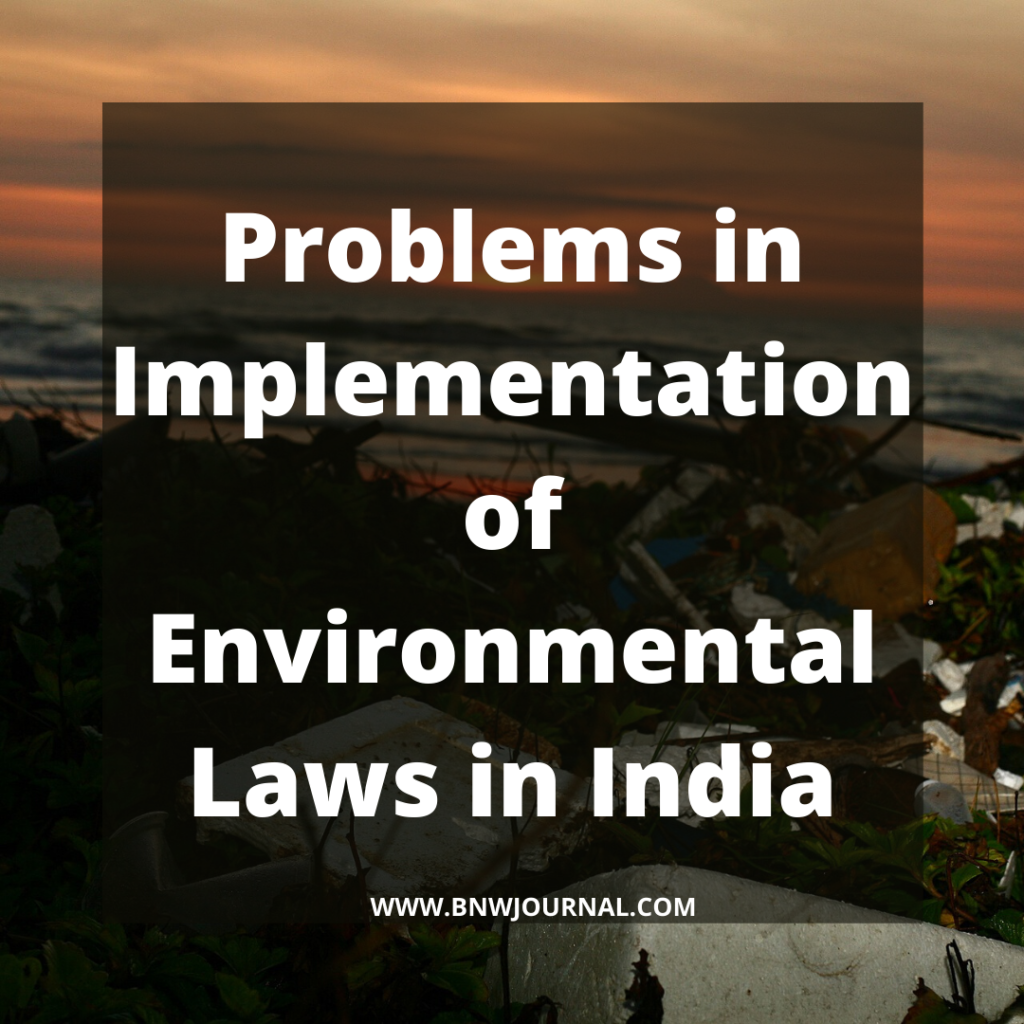![]()
INTRODUCTION
Laws in any nation play a very vital role in eradicating and regulating the pests of crime, inequalities, unwanted customs or beliefs, etc. coming in the way of nation’s progress. But implementing these laws properly is a laborious task than enacting them.

The environment is a major issue emerging in India from the past few decades. Due to increasing industrialization, population, urbanization, and other factors the environment is depleting day by day. Many policies, laws, organizations, etc. are working on the wheel of improvement. The only obstacle in the way of improving the environmentalism in India is the poor implementation of these laws.
Healthy environment of a country does not only encircle in itself the pure and clean natural surroundings; but also define the progress of the nation.
Let us diagnose the depleting condition of the Indian environment, measures taken to improve the condition and difficulties faced.
HISTORY
The history of India is the pure evidence of the connection between man and nature. In each period, of immemorial Indian culture, a strong ethical and moral approach has been traced towards the surroundings. To study the present conditions of the environment in India, we need to track down its essence from the past to the present.
ANCIENT PERIOD
In the ancient period man existed harmoniously with nature. He was dependent on nature for his needs and desires; he did not ever intend to exploit his surroundings. Archaeological evidences from cities of Indus Valley Civilization show the existence environmental awareness even with little development in the field of science and research. Their awareness about hygiene and sanitation is evident from their constructions of ventilated houses, orderly streets, numerous wells, bathrooms, public baths, and covered drains. A small population was another indication of the idea of environmental conservation.
The idea of environmental conservation is very well notable from the rich history of Indian Vedas and their respect for nature. People, during that time, worshiped, nature in the form of gods and goddesses; for instance, in the worship of vanaspati, three thousand branches is like worshiping the entire creation.
Ancient Indians believed that ecological balance is dependent upon actions, good or bad, of individuals and society. It was insisted that every village must have a small jungle where various species of trees were protected and this obligation can be compared with the modern concept of social forestry.
It is evident from many Buddhist scriptures that Buddha preached in vanaropa sutra that people can enhance their merits every day by gardening and planting trees. Buddha in kariya metts sutra insists on compassionate living and also taught his followers to think about future generations. Buddhism also insists that an ideal king is expected to protect not only his people but also forests and animals, as is evident from Asoka’s 5th pillar edict.
Kautilya in Arthashastra laid down certain norms relating to conservation of forests. Penalties were levied on the cutting of trees without the approval of authorities, cutting branches, destroying trunks, and uprooting trees.
MEDIEVAL PERIOD
In the context of the Environmentalism in Mughal era, it has been observed that Mughal rulers were much keener in researching, building, and admiring the natural surroundings and structures rather than culminating any conscious step towards that direction. Akbar’s efforts in promoting afforestation in common property resources, management of water bodies, and his disapproval of killing animals are legendary.
The text on ethics written by Abdul Qadir Badauni begins by a quote that says, “God condemns him who kills a cow, cuts down a tree or sells away a human being.” Commendable steps were taken by Jahangir that made it possible to cultivate high altitude trees like the cypress, juniper, pine and sandalwood in the plains of India. Hunting in the Mughal period was restricted to members of the royal family only. We might say that the Mughals explored the surroundings like naturalists but not like environmentalists but still their efforts helped to preserve the environment in the long run.
MODERN PERIOD (BEFORE INDEPENDENCE)
- The over-exploitation of Indian resources began with the entry of East India Company in India.
- Their main purpose was to fill in British coffers by exporting raw material from India and setting up industries in Britain.
- Over exploitation of timber forests. The Britishers cut down other trees that were teak forests in Malabar in about 1806.
- To turn the cutting down of these forests into a legitimate act, the British government introduced certain policies that prohibit cutting down of trees via any private persons; and only the government can cut them down for trading purposes.
- In 1855, enactment of The Charter of Indian Forests took place which suggested that teak lumber should be retained as state property and its trade strictly regulated.
- In 1864, the first Inspector General of Forests was appointed for organized forest management.
- The Forest Policy of 1894 classified forests into four categories. They are:-
- Forests, preservation of which was essential on climate and physical grounds.
- Forests, which supplied valuable timber for commercial purposes.
- Minor forest which produced inferior sorts of timber
- Pastures which were forests only for the namesake. This policy was opposed by many for the lack of recognition of rights of forest dwellers and unchecked exploitation by the government.
- The Forest Act, 1927 did not bring any change in the exploiting intentions of the British government, the Act gave exclusive powers to the British government.
- Some of the other Acts enacted by the British government were:
- The Shore Nuisance (Bombay Colaba) Act, 1853- to regulate waste discharged in the coastal area
- Oriental Gas Company Act, 1857 – imposed restriction on the Oriental Company to prevent polluting river and seawater.
- Chapter XIV of the Indian Penal Code, 1860- creating the offense of nuisance attempted to protect public health, safety and tried to prevent environmental degradation.
- North India Canal and Drainage Act, 1873 – free flow of canals and rivers for irrigation and drainage.
- Wild Birds and Animals Protection Act, 1912- prohibited hunting of wild birds and animals without the permission of the Forest Department.
Apart from the above enactments several other legislations such as the Poisons Act, 1919, Indian Ports Act, 1908, The Boilers Act, 1923 were concerned with the preservation of environment and conservation of natural resources during British Raj.
POST-INDEPENDENCE PERIOD
Post-independence, India’s approach towards development only centered towards economic development and poverty alleviation and not on resource conservation.
Indian Constitution came into force from 1950; it did not specify any provision relating to environmental protection until, in 1976 when there was incorporation of the 42nd amendment. However, there were sufficient provisions in the constitution empowering both union and state governments to make laws for the protection of the environment and conservation of natural resources.
Based on these provisions in the constitution, enactment of some of the important legislations between 1947 and 1972 took place. They were- The Factories Act, 1948, The Prevention of Food Adulteration Act, 1954, The River Boards Act, The Mines, and Minerals (Regulation and Development) Act, 1956, The Atomic Energy Act, 1962 and The Insecticides Act, 1968.
It was only after The Declaration of The United Nations Conference on the Human Environment, also famously known as the Stockholm Declaration, that India turned its attention towards the broader perspective of environmental protection. The Central Government of India enacted comprehensive (special) environment laws. National Council for Environmental Policy and Planning was set up in 1972 which was later evolved into the Ministry of Environment and Forests (MOEF) in 1985.
The Wildlife (Protection) Act, 1972, aimed at rational and modern wildlife management. The Water (Prevention and Control of Pollution) Act, 1974 provides for the establishment of pollution control boards at Centre and States.
CONSTITUTIONAL INTERPRETATION
In the Constitution (Forty Second Amendment) Act of 1946 explicitly incorporated provisions for environmental protection and improvement.
Article 48A is part of the Directive Principles of State Policy. This declares that the State endeavors to protect and improve the environment; and to safeguard the forests and wildlife of the country. Article 51A (g) in a new chapter entitles ‘Fundamental Rights’. Which imposes a similar responsibility on every citizen ‘to protect and improve the natural environment. This includes forests, lakes, rivers and wildlife and having compassion for living creatures.
In Sachidanand Pandey V. State of Bengal AIR 1987 SC 1109, the honorable Supreme Court holds the court in boundation to bear in mind the above-said articles whenever a case in relation to the environmental problem comes to the Court. In Subhash Kumar V. State of Bihar and Ors.1991, honorable S.C. holds the right to the pollution-free environment declarable as part of Right to Life under Article 21 of the Constitution.
The Forest (Conservation) Act, 1980 aimed to check deforestation, diversion of forest land for non-forestry purposes, and to promote social forestry.
The Air (Prevention and Control of Pollution) Act, 1981 aimed at checking air pollution via pollution control boards.
The Environment (Protection) Act, 1986 is a legislation that provides for a single focus in the country for protection of the environment. It aims at plugging the loopholes in existing legislation. The Public Liability Insurance Act, 1991, provides for mandatory insurance. It is to provide immediate relief to the person affected because of accidents occurring while handling any hazardous substance. Supreme Court of India laid down the principle of liability in the case of M.C. Mehta and Anr. V. Union of India and Ors. Etc.[1] also known as Oleum Leakage Case.
The Biological Diversity Act, 2002, is a major legislation intervention taking affect in the name of the communities. It supposedly involves the protection of biodiversity around them.
In 2006, National Environment Policy (NEP), Ministry of Environment and Forests via the Ministry of Environment and Forests (MOEF) aimed at the conservation of critical environmental resources, intra-generational equity, livelihood security for the poor, environmental governance, etc.
Under the National Green Tribunal Act, 2010, the National Green Tribunal (NGT) set up for effective and speedy disposal of cases about environment protection and conservation of forests.
JUDICIARY’S VIEW ON ENVIRONMENTAL ISSUES
As we have already studied that in above mention landmark cases[2] held Environmental protection as a matter of personal liberty of an individual and also a part of his Fundamental Duties. Thus, we can say up to some extent that the Judiciary’s voice is not absent in this matter. Some of the landmark judgments on environmentalism in India are:
- Rural Litigation and Entitlement Kendra, Dehradun v. State of Uttar Pradesh [3] – introduced the concept of “Sustainable Development”.[4]
- M.C. Mehta[5] v. Union of India[6] – M.C. Mehta filed the writ petition in SC. It highlights the pollution of the Ganga River at the hands of hazardous industries located on its banks. In this historic judgment SC orders the closure of several polluting tanneries near Kanpur.
- M.C. Mehta v. Union of India[7]– (Taj Trapezium Case) SC gave various directions, including banning the use of coal and cake; and directing the industries to use of Compressed Natural Gas (CNG). The issue arose when the Taj Mahal faced threats due to high toxic emissions from Mathura Refineries, Iron Foundries, Glass, and other chemical industries.
- M.C. Mehta v. Union of India[8]– SC ordered cinema theatres all over the country to exhibit two slides free of cost on the environment in each show and the same to be followed by the television network in the country by giving 5-7 minutes to televise programs on the environment.
- T.N. Godavarman Thirumulpad v. Union of India and Ors.- In this case, directions passed since 1995, till the final judgment in 2014. It concerns the livelihood of forest dwellers in the Nilgiri region of Tamil Nadu. This regain had a bad affect from the destruction of forests.
UPHILL TASK OF ENVIRONMENTAL LAWS IN INDIA
In India, there are several legislations, policies, judicial activism, constitutional provisions, etc. regarding environmental protection; but India is still at rank 177 out of 180 countries in environmental performance India results, 2018. This degrading performance of Indian environmentalism shows us that despite all the laws, the nation is unable to protect the environment because of the poor implementation of these laws.
Sunita Narain is the director-general of the New Delhi based non- profit center for Science and Environment. And he says, “We are perfect in the policy department but implementation is a problem. We have weak deterrents. The systems of accountability have been weakened, so monitoring is a huge problem.” Here are the major reasons why India lags in the implementation of these laws:
- Environmental Governance and excessive Governmental control- Ministry of Environment Forest and Climate Change (MOEF) is the main body to look after the environment in India; but there is excessive interference by Government on the Ministry. The body cannot function independently and thus, there is no proper implementation of environmental laws in India.
- Lack of political will and public awareness- Our politics and governance in India majorly focus on other matters like voting rights, economics, technology development, etc. The environment is always ignored. The public is also not aware of the hazardous effects of environmental degradation on their health and other factors.
- Lack of strong penalty measures- Many laws prohibit from undertaking actions hazardous for the environment; but penalty or punishment measures are not taken. For instance, industries are obliged to take permission from the State Pollution Control Board to discharge effluents and causing emissions. But there is laxity in compliance due to the lack of strong penalty measures. Water Pollution Control Act’s penalties for contravention are too weak.
- Lack of independence to Control Boards- There is a lack of independence given to the Central and the State Boards; they still have to depend on the State and Central Government for the appointments.
- Lack of funds and legal authority- These pollution control boards don’t have the legal authority and their decision tend to be overruled by the Government. Pollution Control Boards don’t have enough funds to maintain, proper infrastructure.
- Environmental litigation- is more expensive compared to other disputes as it involves expert testimony and technical evidences.
- Less elastic laws- the laws of India are not much elastic. They give importance only to certain hazardous substances and ignore other categories.
- Pollution Pays Principle- Pollution Pays Principle imposes liability on a person who pollutes the environment. They are to compensate for the damage caused and return the environment to its original state regardless of the intent. The present mechanism fails to accept Pollution Pay Principle.
- Judiciary’s weakness- More than two-thirds of the states/ UTs don’t bother to comply with the orders passed by the Supreme Court; nor do they comply with the directions given by the Ministry of Environment, Forests and Climate Change( MoEF&CC). The judiciary is already struggling to clear the existing backlog of over 21,000 environment-related cases. Lack of respect and poor implementation of the judiciary’s orders only explains the degradation of environment we live in.
- Laws are human-centric- The making of these law are mostly human-centric. They focus on the development and well being of human beings at the expense of the environment. In certain laws where the progress of humans is important, the exploitation of natural resources are common.
- Population- India’s population is still increasing at a fast rate. More population means more pressure on the natural resources. It also brings with it many other problems like poverty, unemployment, etc. which deviates the focus of authorities from the environment to these social issues.
- Urbanization and Industrialization – These two phenomenons are increasing in India from the last 2-3 decades; this is why everyone is busy in the mad race of progress without considering the environment’s exploitation.
SOLUTIONS
- Independent Regulatory Body- there must be an independent body regulating the environmental laws without any interference from the Government.
- High Civil Liability- the citizens are now aware of their liabilities and rights regarding the environmental awareness.
- Penalty and Punishment Mechanism- strict penalties and punishments are a must for implementation of every law enacted according to its violation.
- Focusing on Environmental Progress- the laws must be implemented which are more focused on environmental development than human development only.
- Removing of Loopholes- RTI Act, 2005 enables every citizen to access information about any law or policy in India; but it also has many loopholes that lack the transparency of the government functions. And these kinds of laws are obstacles in the way of proper implementation of environmental protection laws in India.
- Environmental Laws Amendment Bill- which failed to passed in 2015; it tries to impose a fine of 50- 100 million Rupees for causing damage to the environment. It is necessary for better environmentalism in India.
- Lower Courts participation- Beside National Green Tribunal, lower environmental courts are also important to accept more PIL and enhance the implementation.
- Sustainable Development- following a path to Sustainable Development is a must in India.
- Pollution Pay Principle- Pollution Pay Principle, as discussed earlier can be a very good solution for implementing Environmental Laws strictly in India.
- Environmental Jurisprudence- Environmental Jurisprudence frames a strong ethical approach towards environmental development. Thus, it is a must for the progress of environmentalism in India.
- Public Awareness and Political Will- these two aspects play a very important role in implementing and obeying the laws related to the environment in India.
- Boards must be independent- Boards must be given independence for making their decisions and there must a body established of experts just like the civil services.
CONCLUSION
Despite man and nature’s deep connection, a man who used to worship nature has become selfish. In a country like India where every Veda and Upanishad was based on the basic principles of nature is now killing 1.2 million people annually from Air Pollution. Where Rivers like Ganga and Yamuna are still respected like goddesses, there 70% of surface and groundwater is contaminated and unfit for drinking. It’s the high time that we keep on walking single-mindedly towards the economic and technological development without giving any importance to the most important aspect of our existence- Environment. Thus implementation of the Environmental laws in India must be considered a priority of the present time.
The present Covid pandemic has put a halt to many human activities and has at many places revealed that if human activities cease to take place for even a few days then the environment can be restored to its original state and depletion can be overturned if law enforcement is made more stringent and the humans realize the wrongs that they have been doing to the environment.
[1] 1986, SCR (1) 312
[2] In Sachidanand Pandey V. State of Bengal AIR 1987 SC 1109 and Subhash Kumar V. State of Bihar and Ors. 1991.
[3] AIR 1987 SC 2187
[4] Economic Development that is conducted without the exploitation of natural resources.
[5] M.C Mehta is an activist advocate who has single handedly won numerous landmark judgments in regard with environmental protection.
[6] AIR 1988 SCR (2) 538.
[7] AIR 1987.
[8] WP 860/1991.



0 Comments